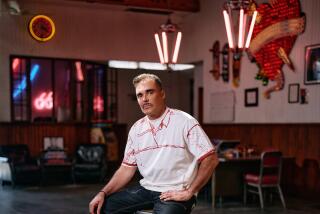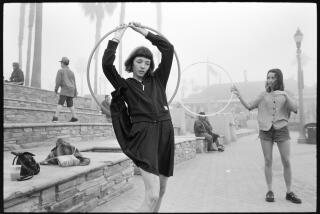Photographer’s work helped define an era’s pop culture
- Share via
William Claxton, the master photographer whose images of Chet Baker helped fuel the jazz trumpeter’s stardom in the 1950s and whose fashion photographs of his wife modeling a topless swim suit were groundbreaking years later, has died. He was 80.
Claxton died from complications of congestive heart failure Saturday morning at Cedars-Sinai Medical Center in Los Angeles, his wife, actress and model Peggy Moffitt Claxton, told The Times.
In a career spanning more than a half century, Claxton also became well known for his work with celebrities including Frank Sinatra and Steve McQueen, who became a close personal friend; but he gained his foremost public recognition for his photographs of jazz performers including Charlie Parker, Dizzy Gillespie, Mel Torme, Duke Ellington, Thelonious Monk and Stan Getz. But it was his photographs of Baker that helped teach him the true meaning of the word photogenic.
“I was up all night developing when the face appeared in the developing tray,” Claxton told the Irish Times in 2005. “A tough demeanor and a good physique but an angelic face with pale white skin and, the craziest thing, one tooth missing -- he’d been in a fight. I thought, my God, that’s Chet Baker.”
Claxton observed that over the years he had taken photographs of some ordinary-looking guys whose faces would just pop out on film. He said that’s what Baker had.
His 1951 photograph of Baker started a relationship that continued for the next five or six years as he chronicled Baker’s rise to fame as one of the most visible jazz performers of the decade.
Claxton called photography “jazz for the eyes” and tried to capture the often dynamic tension between the artist, the instrument and the music.
“For the photographer, the camera is like a jazz musician’s ax. It’s the tool that you would like to be able to ignore, but you have to have it to convey your thoughts and whatever you want to express through it,” Claxton told jazz writer Don Heckman some years ago.
Almost as much as the recordings themselves, the photographs reach into the essence of making music.
“That’s where jazz and photography have always come together for me,” Claxton told Heckman. “They’re alike in their improvisation and their spontaneousness. They happen at the same moment that you’re hearing something and you’re seeing something, and you record it and it’s frozen forever.”
Born in Pasadena on Oct. 12, 1927, Claxton grew up in an upper middle-class family in La Canada Flintridge. His mother was a musician and his older brother played piano; Claxton said he tried the keyboard but had no patience for it. He started collecting records, especially jazz, at an early age. At 2 years old, he was taking the bus to downtown Los Angeles to hear jazz greats, including Ellington, at the Orpheum Theatre.
Years later, he would go to jazz clubs and shoot photographs of up-and-coming musicians just for fun and to listen to the music. An incident that he recounted in the introduction to his book “Jazz: William Claxton” speaks of a more innocent time between celebrities and photographers.
Claxton recalled taking his old 4-by-5 Speed Graphic to photograph the legendary saxophonist Parker at the Tiffany Club on 7th Street in downtown L.A. He hung out with Parker until the place closed and then took him and some of his young fans to his parents’ home in La Canada Flintridge, where he improvised a studio in his bedroom and posed Parker with his fans in a formal portrait. He said that he had never seen Bird, whose life was cut short by drug problems, look happier.
Claxton started at UCLA but gave up college when Richard Bock, who was starting Pacific Jazz Records, hired him as a photographer. He created a vast array of memorable album covers for the label.
Toward the end of the 1950s, he started moving into fashion work. He married Moffitt, who was the muse of fashion designer Rudi Gernreich. In the early 1960s, they created the photographs of the topless bathing suit designed by Gernreich with Moffitt as the model.
“That was a big family decision,” Claxton told Heckman. “Whew. Was I going to let my wife show her breasts in public? We hassled about it for a long time. Finally, we decided to employ nepotism. Only I could photograph it, we would have control of the pictures and Peggy would never model the suit in public. And it worked out OK. The pictures were tasteful, I thought, Peggy looked great, and it was historically a breakthrough for women, that they could feel free enough to show the beauty of their breasts.”
Claxton also directed the film “Basic-Black,” which is viewed by many as the first fashion video and is now in the collection of the Museum of Modern Art in New York.
While taking assignments for Life magazine, he photographed Sinatra at a recording session at Capitol Records, Barbra Streisand in New York, and McQueen. All were notoriously tough assignments, stars distrustful of the media and reluctant to be photographed. But he gained their trust and developed a friendship with McQueen through their common love of sports cars, race cars and motorcycles.
His work is collected in an array of spectacular books, including “Jazz: William Claxton,” “Young Chet,” “Claxography,” “Steve McQueen” and “Jazzlife.”
Claxton is survived by his wife of 49 years; his son Christopher; sister Colleen Lewis of Eagle Rock; and several nieces and nephews.
A memorial gathering is being planned.
--
More to Read
The biggest entertainment stories
Get our big stories about Hollywood, film, television, music, arts, culture and more right in your inbox as soon as they publish.
You may occasionally receive promotional content from the Los Angeles Times.









